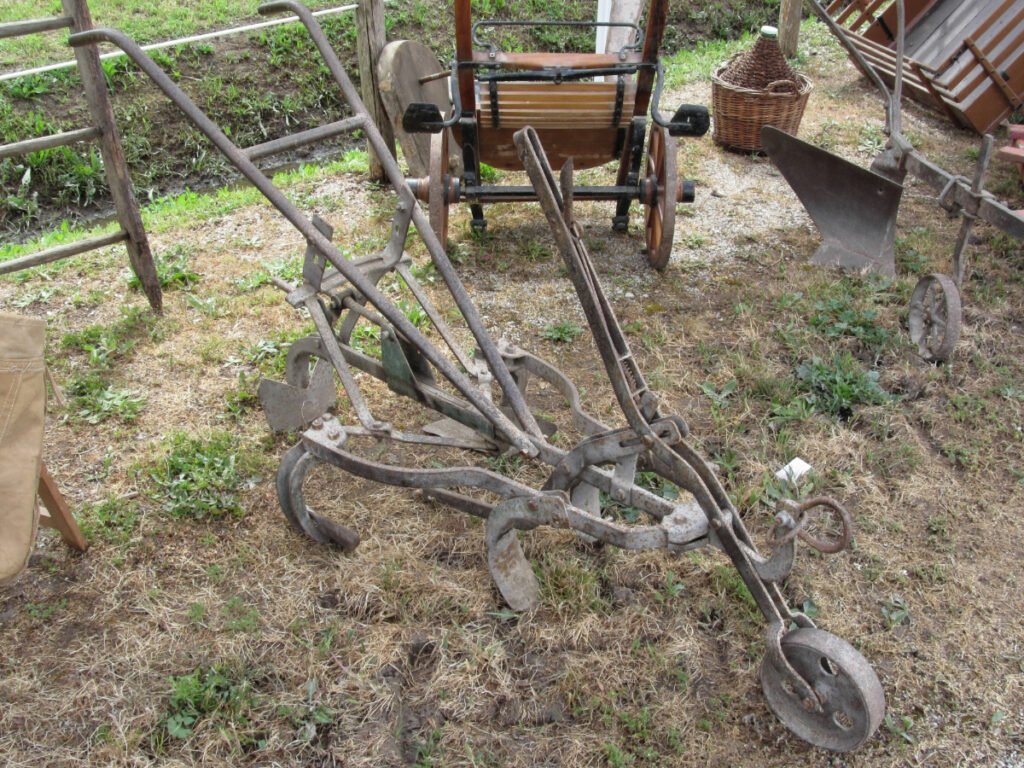Antique plows are a precious souvenir for any rock garden! But have you ever seen their first-edition models? Old plows are so crude that you might mistake them for real and lose your money. Want to save yourself from such scams? Well, here’s how you can do it!
First, you’ll need to identify the features and calculate the value. No, it isn’t as numerical as it sounds. In fact, I’ll tell you how to do it step-by-step here. So, just get a pencil, and let’s do it together!
Key Takeaways
- Look for large plow wheels, wooden handles, and tilted designs to pick authentic plow models.
- Vintage plows with bare wood, metal, or black finishes are handmade and precious. But, if you want it to be unique, pick exclusive colors like green and red.
- Pick old plows with a stone, cast-iron, or wood blade for the best returns. And fancy shapes like hooked or moldboard plows will boost the value further.
- You can explore three types of antique plows – walking, animal-drawn, or tractor-drawn. And their value depends upon many factors like age, material, and brand. So, let’s dive in further to know it all!
Key Identification Features of Real Antique Plows

Antique plows look like any other farming plow. But you’ll see larger iron wheels and slender drawbars on their edge. They may also have tilted and tall handles, unlike modern plow designs. And their logos and marks will also help you track their authenticity!
But you won’t find branded plows every time! So here are some other features you must check out:
- Wooden body and wrought iron nails with a stucco cover on top
- Curved, animal-shaped handles with hand polish or lacquer
- 20-24” wheels and a tubular, 3-feet beam for support
- A shark tooth, fireball, or raindrop blade finish for better strength
- Wood-burnt logos, dates, and other maker marks on the central shaft
History & Evolution of Farming Plows
Did you know that the first wooden plows are as old as 4000 years in age? Built by the Egyptians, they were more like spears that raked the soil. Plus, they weren’t sturdy and caught mold with time. But being handmade, you’ll get the best value for them!
It was in 1797 that Charles Newbold made the first cast-iron plow. But to his surprise, it didn’t go quite well with American farmers then. In fact, they thought that it poisoned the soil and stopped its production. So, you’ll have to search harder if you want these plows.
The late 19th Century plows were mechanical. So you can spot their industrial designs and soft-steel blades. But since they were thin and easy to bag, the value and demand went down.
3 Types of Vintage Plows (With Values)
Identifying the types of plows is the first step to better valuation! Here, let’s break down the plow’s type and design and calculate a basic cost range.
So here are three main types, along with the key features for help!
1. Walking Plow

Walking plows are just like the doodled plows in storybooks! They’re portable, and a farmer pulls them all through the field. Also, note their rotating blades and levers that make manual work easy!
They also have 2-6 foot diggers and are helpful in uneven terrains. Plus, most of these models are handmade and hand-jointed. So, you’ll get a high value of $3500 – 4000.
2. Cattle-Drawn Plows

Just as the name suggests, cattle-drawn plows are ox-pulled. So, they are larger and heavier than others. They also have tall handles and iron beams to fit on top of the animal. Most have 6-feet diggers, but you can get 4-foot models for calves.
However, cattle-drawn have some metal parts. So, they obviously rust and degrade with time, and down goes the price range of $2000 – 2500.
3. Ride-Along Plows

Ride-along models are the regular tractor-pulled plows you see today! They are more user-friendly and have adjustable depths and blades. Plus, you’ll get them in bold colors – red and green with a double-slit fence on both ends.
But since these plows are factory-made, they aren’t unique and cost only $100 – 200.
6 Factors to Identify & Value an Antique Plow
Now that you have identified your plow type, let’s move to the next step – identifying the factors like its date, brand, and materials. Check out these six factors to value your piece!
1. Manufacturing Date and Age
Talking about the age, early plows from the 1750s were basic. Like they came with a stick and an iron digger. But their high-duty materials and hand-joint finishes make them precious, valued as high as $8000.
Plows from the 1800s are also precious because of their rarity and designs. But, you must look for a crude squarish handle and low blade. If it’s there, your piece can be valued at $5000.
Next are the steel plows from the 1900s. Usually, they are cheaper, but you can get branded pieces for more value.
Want more help in dating your antique plow? Worry not! I’ll tell you more!
How Do You Identify Old Plows from the 1700s?
Plows from the 1700s look just like a dart. They have a tubed beam at the top and a pointed blade down. You can find a 2-3 foot digger and unique moldboards with them. So, they use less energy and put point pressure on, just like an old knife.
But, they won’t have any logos or maker marks. So, look for carved blade patterns, hand-cut edges, and 5-6 feet rods to spot them. Depending on the size, you can get them for $4000 – 8000.
How Do You Spot Vintage Plows from the 1800s?
Plows from the 1800s are more functional. So, you can expect them to have 5-6 feet diggers, carved surfaces, and low-rise handles. You can even look for two-bottom moldboards and thicker drag rods, costing $1000 – 5000.
How Do You Know If Your Antique Plow Is from the 1900s?
If your plow has a steel blade and rubber handles, it’s definitely from the 1900s! You can rotate its beam and check for logos or patent numbers to trace the age of your piece. Overall, you can value them from $100 – 500.
Let’s look at some common plow patent numbers:
| Year | Age | Patent Number | Vintage Plow Type | Average Valuation |
| 1900 | 123 years | US721241A | Snow Plow | $250 – 300 |
| 1865 | 158 years | US46454A | Walking Plow | $400 – 500 |
| 1873 | 150 years | US164929 | Sulky Plow | $300 – 400 |
Try to get plows with any historical ties or royal origins to boost the cost.
2. Antique Plow Blade & Body Shape
Not all early plows are straight and pointed. In fact, if you look at the rare models, you’ll notice their curved beams and metal tips. Many of them, like the Rau Plow from the 1800s, might even have a handle to maintain their upright position.
Now let’s explore the 1850s. Plows from this era had curved beams and a straight drag bar. So, they look triangular and have two-piece designs for quick assembly. But many of them, like the Moroccan plow, are brittle and cheaper.
The later 1870s plows are boxy. They have a moldboard that loosens the soil and are linear and stiff. You can also get them with pointed or crossed blades at a higher valuation.
| Shape of the Plow | Average Valuation |
| Hook shaped | $300 – 400 |
| Handled or Rau Plow | $250 – 350 |
| Moroccan Plow | $100 – 200 |
| Triangular Plow | $100 – 200 |
| Moldboard Plow | $200 – 300 |
3. Plow’s Color

The lesser the alterations, the more the plow value! So, naturally, the bare wood and metal plows earn the highest price. Other than that, neutral, charcoal-finished black or gray handles are precious. The same is true for oxidized colors like red and orange as well.
But blue plows from the late 1850s are oil-painted. You can still get $60 – 70 for alloyed gold and silver plow colors from this era. But overall, they are cheaper than natural metal color plows.
| Plow’s Color ( Handle or Beam) | Average Valuation |
| Bare Wood or Metal | $100 – 200 |
| Black, White or Gray | $80 – 100 |
| Red, Orange, Yellow, or Green | $70 – 80 |
| Beige, Blue, and Dark Blue | $40 – 50 |
| Silver or Golden | $60 – 70 |
| Polished or Galvanized | $20 – 30 |
You can get red plows in newer, galvanized finishes as well. So rub your finger and check for a powdered texture before buying one.
4. Antique Plow Parts & Materials

Antique plow handles were always wooden, just like today! So, it’s the blade material that makes a difference! For instance, oak wood or stone blades are quite old and precious. And even hand-molded cast-iron blades trace back to the 18th Century.
If your blade is gray iron, it’s from the 1850s, and if it’s alloyed steel, it’s from the 1870s. You can price them for $200 – 300.
But your plow is newer and cheaper if it’s made from stainless steel. Likewise, even brittle aluminum or zinc plows are less precious.
| Blade Materials | Average Valuation |
| Local Stones – Sandstone or Granite | $600 – 700 |
| Oak or Beech Wood | $500 – 600 |
| Cast Iron | $300 – 350 |
| Gray Iron or Alloyed Steel | $200 – 300 |
| Spring Steel | $100 – 120 |
| Stainless Steel, Aluminum, Zinc | $40 – 50 |
Avoid getting plows with blunt or chipped blades as they might devalue your piece by 10 – 12%.
5. Branding
If your shop gives you 2-3 antique plow options, pick the one by ‘Deere’ or ‘Oliver.’ Why? Because these branded plows raise the valuation by 5-10%.
And these might even have an Italian or Indian make. So, you can even find traces of exotic wood or silver with them. But how do you know if a plow is branded?
Simple! Check their drag rods for a logo or deer trademark. You can even look for bold font slogans on their moldboards to trace the make.
Want to know more? Here are some vintage plow brands for reference:
| Old Plow Name | Manufacturer | Antique Plow Type | Average Valuation |
| Bottom Switch Plow | John Deere | Moldboard Ride-Along Plow | $5500 |
| 8-Bottom Land Plow | John Deere | Walking Plow | $8000 – 9000 |
| Two Plow Plow | Parlin & Orendorff | Horse-Drawn Plow | $3000 – 4000 |
| 2-Bottom Land Plow | Oliver | Cattle-Drawn Plow | $1000 – 1500 |
Check the company’s logo for a green monogram and yellow rims to spot the authentic ones.
6. Restoration
Vintage lovers look for original, handmade finishes when buying any antique item. So, any restored or polished plow will lose its valuation by 12-13%.
Similarly, reselling the plow will be difficult if you change its handles and wheels. In fact, you might get less than $10-15 for such restored plows.
What Is the Difference Between an Antique Plow and a Vintage Plow?
Antique plows are more than 100 years old, while vintage plows are 60-70 years old. So antique plows are crude, wooden, and tilted. In contrast, vintage plows have soft steel blades and easy-to-lift handles. Plus, most of them are battery or tractor-operated.
What Is an Antique Plow Called?
Antique plows are also called grasshopper plows because of their tilted shape and thin designs.
How to Clean Antique Plows?
You can clean antique plows by gently scrubbing them with a soft brush and oiling their parts. Just make sure to use softer cork scrubbers and non-abrasive cleaners to retain the original finish.
So, one thing is for sure, the older and more handmade the plow, the more its value! So, if you want a good artifact, pick crude wood and branded walking plows for better value.
Antique plows are great farming collectibles for all garden lovers there! But, if you’re a DIY buff, you can pick antique crosscut saws as well. Not only are they sturdy, but they have a unique blade pattern. You can refer to our article if you plan to buy one!









